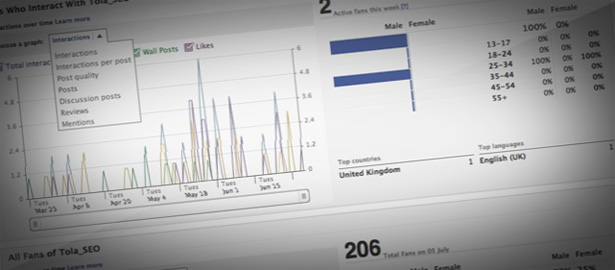Although no two Facebook pages are the same, there are some similarities that appear across multiple pages.
There are four main stages your page goes though, and once you identify the stage your page is in, you can use some standard tips and tricks to get it to the next level.
Sometimes pages will naturally progress from stage to stage, sometimes they’ll go backwards, and sometimes they won’t fit any stage at all! Don’t worry– just keep your eyes on where you want your page to be, and work towards that.
Stage 1: Getting your page off the ground.
When Facebook pages are new, the community is still finding the boundaries and tone of the page. It is at this stage you can easily convert brand advocates though quick wins, answering questions and being the good guy.
By turning your early fans into brand advocates, they will help you monitor and set the tone for your page when it enters stage 2. These fans are likely to be your friends, family and workmates, so be explicit about asking them to be active on your page. Honest – but active.
Tips for a page in stage 1
- Think like the person you want to attract. What would they like to see on your page?
- Post regular, interesting and infomative content – posting no more than four times a week and no less than once a week.
- Keep your tone friendly. Facebook recommend you “push” in only 20% of status updates. The other 80% should be relationship-building.
- Set your spam filter, and any keywords. Pick wisely as to not stifle the natural conversation, but to not allow any content that may disturb your audience.
- Fully complete the “info” section of the Facebook page.
- Set flexible strategies around dealing with negative feedback now. Where are your brand’s boundaries around negative posts? Should you allow them on your Facebook page? (I say yes, by the way, that’s a natural part of being in a public forum. Don’t delete it unless the language is filthy or threatening.)
- Create a landing page that explicitly asks people to like your page.
- Upload lots of photos and any videos you have to make the page interesting and useful.
- Read Facebook’s brand page terms and conditions.
- Get a username (facebook.com/username) once you have 25 fans. Make it short and to the point. This URL will help you in stage 2.
Stage 2: Building momentum with existing fans
Reach out to your existing fans by promoting your Facebook page to them using the custom URL. This may involve putting a social plug-in on your website, a mention in your e-letter, or a notice on your front counter or shop window. They already like what you have to offer, why not make it easy for them to find you on Facebook?
Tips for a page in stage 2
- Keep an eye on your page’s insights to see who your fans are: Their locations, demographics, what they most respond to on your page, what they’re clicking on. If they don’t match your wider marketing plan, something’s a little off.
- Be seen to be responding to feedback, good and bad alike. Seek feedback from your fans and act upon it. If they say they’d like to see x happen, and it’s reasonable, make x happen. If it’s not, be honest about that.
- Keep an eye on what’s going into your spam filter and restore anything that’s been mistakenly tagged as spam.
- Find pages similar to yours and see what works on their page. Try similar things on yours to see if they work with your audience.
- Plug your website into Facebook insights to see the demographic that’s impressing against your social plug-ins. Who are you not converting to a Facebook fan?
- Keep an eye on which posts get the most impressions – what time of day were they posted?
Stage 3: Time for a push
This is the stage where your page is doing ok, but could do with a boost. Consider some advertising. Facebook ads can cost as little as 60cents CPM. You may want to add your custom URL to any external advertising you have running as well.
This means you’ll be getting a lot of random likers – which can often mean trolling. Don’t be afraid to ban troublemakers – but be sure that’s what they are first! Often we can mistake grumpy customers as trolls and not treat them the way they deserve.
If you’ve done stages 1 and 2 well, your loyal fans will help weed out trolling, and be able to answer basic questions for users – Dell found this a useful tactic when coming out of their Dell Hell phase.
Tips for a page in stage 3
- Lots of new people will be hitting your landing page – adjust it slightly so anyone can understand why they should like your page. “Like our page to hear about special offers” etc.
- Create custom tabs – for example a FAQ section or latest news section might be a good start.
- Logged in as your brand, like and write on the walls of any brands that compliment or partner with yours. Check with their page admins first if you can, and don’t be cheeky about it or they may ban your page.
- Empower, support, and reward users who want to be brand advocates, and acknowledge them for their help.
- Make sure your community mangers are equipped to deal with negative feedback – both professionally and personally.
- Don’t run promotions where users leave a comment or upload a photo to enter. That’s against Facebook’s terms and conditions and you may come out with egg on your face.
Stage 4: Organic growth
At this stage your page should be pretty healthy and you should have strategies in place for processing trolling, negative feedback, suggestions, and answering questions you don’t always have answers for. There’s an interesting phenomenon that I noticed – and have had confirmed to me by other major account managers across multiple brand types and sizes – that you no longer need to run ads during this stage, and the page will grow exponentially.
Don’t be alarmed when the growth starts to level out. The size of your page when this happens depends on your reach, and the profile of your business. Your organic growth may slow to 1 – 2 % per week.
Tips for a page in stage 4
- Don’t rest on your laurels. Set big engagement and impression goals. Continue to evolve your page, being lead by your fans and wider business objectives.
- Keep an eye on hide rates and unlikes and moderate your postings
- Crowd source. There’s likely to be some users with amazing ideas for your business, or some feedback trends going on.
- Consider another ad spend.
This is by no means a fully comprehensive list of things to check off with a Facebook page, and may not be applicable to all brands. In fact, this is quite general, and somewhat oversimplified compared to reality and the curveballs that get thrown at you.
The main thing you need to keep in mind is to think like a page user. What do they want? Deliver that and you can’t go wrong.

